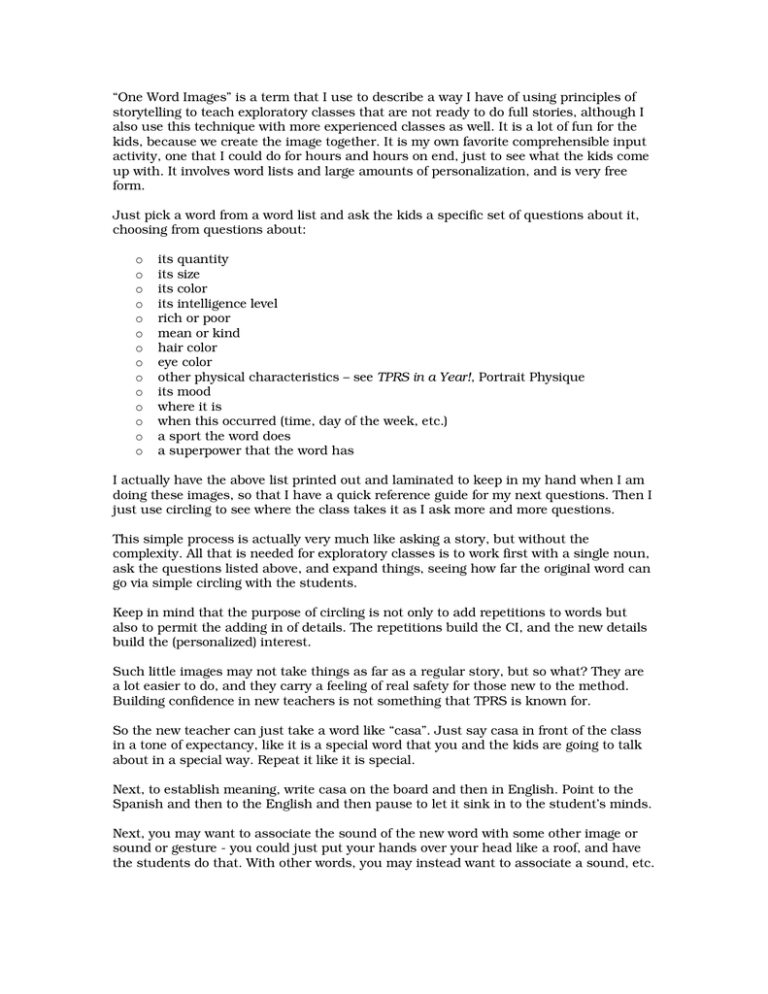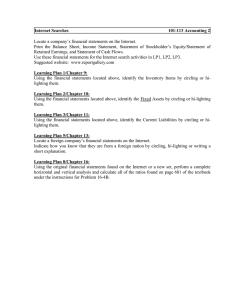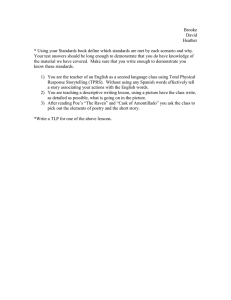One Word Images
advertisement

“One Word Images” is a term that I use to describe a way I have of using principles of storytelling to teach exploratory classes that are not ready to do full stories, although I also use this technique with more experienced classes as well. It is a lot of fun for the kids, because we create the image together. It is my own favorite comprehensible input activity, one that I could do for hours and hours on end, just to see what the kids come up with. It involves word lists and large amounts of personalization, and is very free form. Just pick a word from a word list and ask the kids a specific set of questions about it, choosing from questions about: o o o o o o o o o o o o o o its quantity its size its color its intelligence level rich or poor mean or kind hair color eye color other physical characteristics – see TPRS in a Year!, Portrait Physique its mood where it is when this occurred (time, day of the week, etc.) a sport the word does a superpower that the word has I actually have the above list printed out and laminated to keep in my hand when I am doing these images, so that I have a quick reference guide for my next questions. Then I just use circling to see where the class takes it as I ask more and more questions. This simple process is actually very much like asking a story, but without the complexity. All that is needed for exploratory classes is to work first with a single noun, ask the questions listed above, and expand things, seeing how far the original word can go via simple circling with the students. Keep in mind that the purpose of circling is not only to add repetitions to words but also to permit the adding in of details. The repetitions build the CI, and the new details build the (personalized) interest. Such little images may not take things as far as a regular story, but so what? They are a lot easier to do, and they carry a feeling of real safety for those new to the method. Building confidence in new teachers is not something that TPRS is known for. So the new teacher can just take a word like “casa”. Just say casa in front of the class in a tone of expectancy, like it is a special word that you and the kids are going to talk about in a special way. Repeat it like it is special. Next, to establish meaning, write casa on the board and then in English. Point to the Spanish and then to the English and then pause to let it sink in to the student’s minds. Next, you may want to associate the sound of the new word with some other image or sound or gesture - you could just put your hands over your head like a roof, and have the students do that. With other words, you may instead want to associate a sound, etc. When you do this, the neurology is such that the kids will quickly decode it when it comes up later, relative to the number of repetitions you are able to get in via the circling you do around the word. This word - casa - is just the first brick of a little image you are going to build! It may or may not become a scene, but for now it is just a little image, a little brick. But in that image is a potential story! Each new word added to casa, as you work with your students without English to build the image, can contribute to the eventual building of a beautiful and hilarious story - a home run story. So you say casa and if the students are beginners you then say una casa and then you ask about a color for the house and then you ask if the house is big or small and big or small in relation to what and soon a person walks into it and something happens and you are off and running with a story. That’s it! You just build a little red house together and if it develops into anything more than that, great, if not, the kids are hearing and understanding the language via the circling you are doing, which is the point of the whole thing. And you are getting valuable training that will lead to your building an entire story using TPRS. To repeat, the purpose of circling is to get these repetitions, of course, but circling also sets up little gaps after each question you ask into which the students can suggest details in the form of cute answers. When students suggest cute answers to your circled questions you are going to be successful with TPRS because your students will then have ownership in the process - it will be their image, their story. It is normal! The kids in a TPRS class have to feel a fairly large degree of ownership in the building of the story or the story won’t be interesting to them. Thus, the building of a story must always be done by the group, not by the teacher alone. It also must be done without English except when you write each new word and its translation on the board, or when you allow the kids their two word suggestions in response to your questions. So people new to TPRS may want to consider this idea. Instead of swinging for the fences, just try for the bunt or the single - just make contact with the ball by circling single words into little images first, and only after that into little scenes, and finally, when you are ready, ramp one of those little scenes into a story. It is further suggested that this technique of building images from a single word, in addition to the PQA technique of circling with balls, be used to in all TPRS exploratory classes, as well as in all TPRS first year classes during the first 3-6 weeks of the year.

